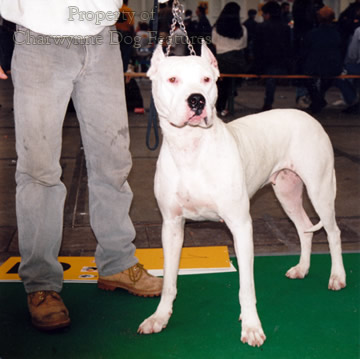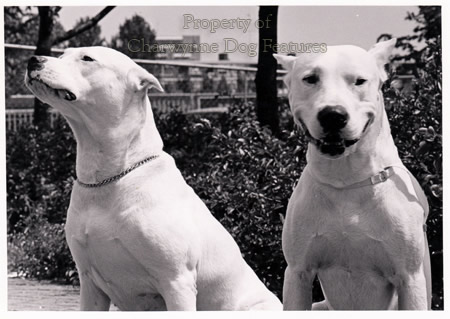843 THE ARGENTINIAN MASTIFF
THE ARGENTINIAN MASTIFF - The Dogo Argentino
by David Hancock

The Dogo Argentino, is foolishly banned from Britain under the absurd Dangerous Dogs Act (absurd because it brands breeds as dangerous rather than the social misfits who misuse such powerful dogs) - the breed not being recognised as a heavy hound or running mastiff. The Argentinian Mastiff is expected to be a hound of the chase or running mastiff and a capture dog, when used to hunt wild pig in its native country. The Alano of Spain was probably the original form of the hunting mastiff in Argentino, taken there by colonists. Spanish explorers first reached the coastal areas in 1516 and settlers quickly followed in search of gold and silver. The second largest country in South America and the eighth largest in the world, it features the Gran Chaco, a forested region famous for its big game. Wild pig destroy crops; pumas attack cattle. The Argentinian farmer has long had a need for big game hunting dogs.
Big Game Hound Need
This need was met by the Alano/Perro de Presa dogs taken to Argentina by settlers. Later, the Perro de Pelea Cordobes, or Cordoba Fighting Dog, mainly white and renowned for its ferocity became a component in the local 'boar-lurchers'. The Argentinian city of Cordoba was a base for English railway workers in the 19th century and some are known to have brought their pit-dogs with them. Bull-fighting and cock-fighting were banned in the mid-19th century but dog-fighting persisted into the 1920s. The end of dog-fighting could have led to the loss of the brave dogs misused in such a barbaric contest, but the desirable qualities in them were recognised by Dr Antonio Nores Martinez in his quest for a dog to hunt boar and puma, both enemies of the farmer. 
Need to 'Seize and Hold'
Dr Martinez spelt out the essential qualities desired in an Argentinian big game hound at a lecture in 1974: a hound which did not give tongue until confronting its quarry; a hound able to seek air-scent with a high nose, comparing this feature to that of the Pointer; a hound with scenting powers rated ahead of sheer pace and a resolute animal, not afraid to tackle a dangerous quarry. He stressed that a hound which could not 'seize and hold' its prey was valueless, mainly because of the immense physical demands made on hunters in the terrain favoured by the quarry. It was vital to have a successful conclusion to such physically stressful hunting in the mountain forests. It is no coincidence that breeds like the Dogo Argentino, the Perro de Presa Canario, the Cane Corso, the Perro Cimarron and the Fila de Sao Miguel, despite coming from different countries have almost identical jaws; function decided form. Blended Blood
Blended Blood
It is alleged that the blood of the Pointer, the Dogue de Bordeaux and the Boxer (and some reports say Great Dane, Foxhound, Bullmastiff and Bull terrier blood too) was blended with that of the remaining fighting dogs, but that finally Irish Wolfhound and Pyrenean Mastiff blood was introduced. This seems a strange mixture of rough-coated and smooth-coated breeds, breeds with conflicting instincts and hunting aptitudes and too little scenthound input. It would have made more sense if a combination of Great Dane, Bull Terrier, Foxhound and the big white Bulldogs used for hog-catching in the United States had been tried. This would have produced the white smooth-coated dog desired, with scenting powers ahead of speed and with pinning instincts well to the fore. It would be of value one day to discover the actual breed mix, for the outcome has been highly successful and a fine hunting mastiff developed.
Eliminating Dog Aggression
Both Antonio Nores Martinez and his brother Agustin admitted experiencing great difficulty in eliminating dog-aggression from their stock. I suspect this may have been caused by a lack of socialisation when the dogs were young, perhaps inevitable when a large number of dogs are kennelled, a lack of skilful training during the dogs' development and a failure to differentiate between gameness, i.e. spirit, determination and courage, and undesirable aggression, exemplified by bullying, irrational bad temper and unpredictable savageness. Hounds used in the boar hunt, and to face pumas, need fearlessness, dash and boldness but not unstable temperaments.
Daunting Quarry
Wild pig, whether an enraged 200kg sow or a lighter peccary, with its formidable teeth, makes a terrifying adversary. A boar will face a dog without fear and is capable of ripping open a dog's flanks with its fearsome tusks. The puma that raids the herds of Argentinian cattle, concentrating on the calves, can tear a dog to shreds when fighting for its life. A running mastiff that is expected to be a catch-dog too would need the thicker skin and powerful jaws of the holding dogs, as well as the stamina, pace and scenting skills of a 'par force' hound. The specimens that I see at shows abroad have surprisingly thin skin for a dog with this function-led breeding, but they do have commendably stable temperaments.
Ban on Breeds Unfounded
The banning of this breed from Britain, under The Dangerous Dogs Act and its temporary import restrictions, was unjustified. It is ill-informed to ban any breed; this one appears well-behaved with other dogs and well-disposed towards strange dog-show judges opening the mouths of exhibits in the ring. This is a handsome breed, with a natural grace, impressive muscularity and obvious athleticism. Any powerful dog, over two feet at the withers and weighing 40-46kgs, bred to have spirit, could be a menace in the wrong hands or kept in unsuitable conditions. To ban the breed because of what some misguided 'authority' has claimed and despite what specimens of the breed demonstrate as characteristic behaviour is irrational. To ban the national breed of another country and one purpose-bred by two well-intentioned doctor brothers is not exactly admirable or a contribution to animal welfare. British breeders could so easily continue the work of the Martinez brothers and produce some quite magnificent examples of this splendid breed; they just need the opportunity.